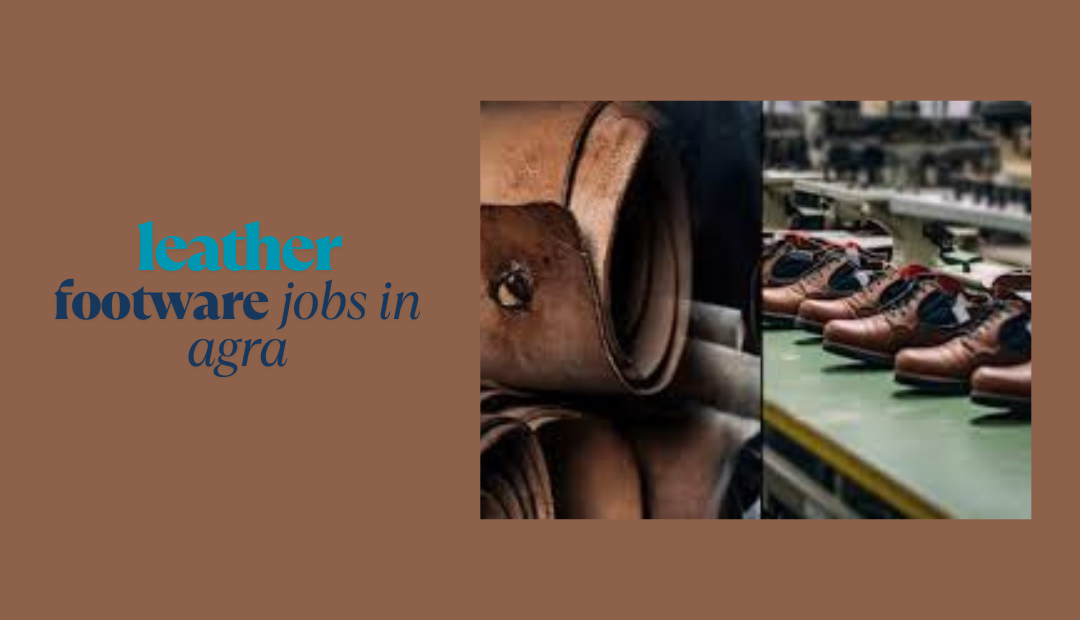Leather footwear jobs in Agra represent one of the most promising career paths in India’s traditional manufacturing sector, where centuries-old craftsmanship meets modern industrial demands. As the beating heart of India’s leather industry, Agra has evolved from a Mughal-era center of excellence to become the country’s largest footwear manufacturing destination, employing over 500,000 skilled artisans and workers across various specializations.
The Golden Corridor of Shoe Manufacturing Excellence
Agra’s transformation into India’s leather capital stems from its strategic geographical position and rich artisanal heritage. The city produces approximately 65% of India’s total footwear exports, generating revenue exceeding ₹15,000 crores annually. This massive industry creates diverse employment opportunities ranging from traditional cobbling to high-tech manufacturing processes.
The leather cluster in Agra encompasses over 8,000 registered units, from small-scale family businesses to large export houses. Major industrial areas like Sikandra, Artoni, and the Agra-Delhi highway corridor house numerous factories where skilled craftsmen transform raw hides into premium footwear destined for global markets.
Diverse Career Pathways in Leather Footwear Manufacturing
Traditional Craftsmanship Roles
Master cobblers and artisans form the backbone of Agra’s leather industry. These experienced professionals, often carrying forward generational skills, specialize in hand-stitching premium shoes, creating intricate designs, and maintaining quality standards that have made Agra footwear globally recognized. Entry-level positions for leather cutting, sole attachment, and finishing work typically offer starting salaries of ₹12,000-18,000 per month.
Specialized roles include pattern makers who create templates for different shoe designs, lasting experts who shape shoes over forms, and finishing specialists who apply final touches including polishing, buffing, and quality inspection. These skilled positions can command salaries ranging from ₹20,000 to ₹40,000 monthly.
Modern Manufacturing Opportunities
Contemporary leather footwear production in Agra increasingly incorporates advanced machinery and technology. Machine operators working with computerized cutting equipment, hydraulic presses, and automated stitching machines represent the new generation of leather workers. These technical roles require formal training but offer better working conditions and higher compensation packages.
Quality control specialists, production supervisors, and floor managers oversee manufacturing processes, ensuring compliance with international standards required for export markets. These supervisory positions typically require vocational training or diploma qualifications and offer salaries between ₹25,000-50,000 per month.
Design and Development Careers
Fashion designers specializing in footwear create innovative designs that blend traditional Indian aesthetics with contemporary global trends. Product development managers work closely with international buyers to develop new collections, while technical designers ensure manufacturability and cost-effectiveness of new designs.
These creative roles require formal education in fashion design or related fields and offer excellent growth prospects with leading export houses. Senior designers and brand managers can earn ₹60,000-1,20,000 monthly while working with renowned international brands.
Export Market Dynamics and Career Growth
Agra’s leather footwear industry serves major global markets including the United States, European Union, Japan, and Australia. This international exposure creates numerous opportunities for professionals to work directly with foreign buyers, understand global quality standards, and develop expertise in international trade practices.
Export documentation specialists, international marketing executives, and buyer relationship managers play crucial roles in maintaining Agra’s position as a preferred sourcing destination. These roles require English proficiency and understanding of international business practices, offering salaries ranging from ₹30,000-80,000 per month.
Essential Skills and Training Requirements
Success in Agra’s leather footwear industry requires a combination of traditional craftsmanship skills and modern technical knowledge. Basic leather working skills can be acquired through apprenticeship programs offered by established manufacturers, typically lasting 6-12 months.
Formal training institutions like the Central Leather Research Institute (CLRI) extension center in Agra provide comprehensive courses covering leather technology, footwear design, and manufacturing processes. The Footwear Design and Development Institute (FDDI) campus offers specialized programs that combine technical expertise with business knowledge.
Key skills include leather selection and quality assessment, pattern making, cutting techniques, stitching methods, lasting processes, and finishing applications. Additionally, knowledge of export documentation, quality standards like ISO certifications, and basic computer skills enhance career prospects significantly.
Entrepreneurial Opportunities and Business Development
Agra’s leather ecosystem strongly supports entrepreneurship, with many successful manufacturers starting as small-scale craftsmen. The availability of skilled labor, established supply chains, and buyer networks creates favorable conditions for starting leather footwear businesses.
Government schemes like MUDRA loans, cluster development programs, and export promotion initiatives provide financial support for new entrepreneurs. Many professionals transition from employment to entrepreneurship after gaining 5-10 years of industry experience, establishing their own manufacturing units or trading businesses.
Salary Structures and Career Progression
Entry-level positions in leather footwear manufacturing offer monthly salaries between ₹10,000-18,000, with rapid progression possible based on skill development and experience. Skilled craftsmen and machine operators typically earn ₹18,000-35,000 per month, while supervisory roles command ₹30,000-60,000 monthly.
Senior management positions, including production managers, export managers, and technical heads, offer compensation packages ranging from ₹60,000-1,50,000 per month, often including performance incentives and profit-sharing arrangements.
Future Prospects and Industry Evolution
The leather footwear industry in Agra continues evolving with increasing automation, sustainable manufacturing practices, and digitalization of processes. Industry 4.0 technologies, including IoT sensors for quality monitoring and AI-powered design software, are gradually being adopted by progressive manufacturers.
Environmental compliance and sustainable production methods are becoming increasingly important, creating new roles for environmental engineers, waste management specialists, and sustainable design experts. The growing domestic market, coupled with expanding export opportunities, ensures robust job growth in this traditional yet dynamic industry.
For aspiring professionals, leather footwear jobs in Agra offer a unique combination of preserving tradition

Leave a Reply